fuse CHEVROLET MALIBU 1997 5.G Owners Manual
[x] Cancel search | Manufacturer: CHEVROLET, Model Year: 1997, Model line: MALIBU, Model: CHEVROLET MALIBU 1997 5.GPages: 354, PDF Size: 18.87 MB
Page 9 of 354

Downloaded from www.Manualslib.com manuals search engine 1
Vehicle Symbols
These are some of the symbols you may find on your vehicle.
For example,
these symbols
are used
on an
original battery:
POSSIBLE A
CAUTION
INJURY
PROTECT EYES BY
SHIELDING
Q
CAUSTIC
BURNS
AVO1 D
SPARKS
OR
FLAMES
SPARK
OR ,111,
COULD [-sr=l
FLAME
EXPLODE BAlTERY
...
These symbols
are important
for you and
your passengers
whenever your vehicle
is
driven:
DOOR LOCK
UNLOCK
These symbols
have
to do with
your lamps:
SIGNALS @ e
TURN
FOG LAMPS
$0
These symbols are
on some of
your controls:
WINDSHIELD
WIPER
WINDSHIELD DEFROSTER
WINDOW
DEFOGGER
VENTILATING FAN
These symbols
are used on
warning
and
indicator lights:
ENGINE t
COOLANT kt-
TEMP -
CHARGING I-1
BAlTERY
SYSTEM
BRAKE (@)
COOLANT a
ENGINE OIL e,
PRESSURE
ANTI-LOCK
(a)
BRAKES
Here are some
other symbols
you may see:
FUSE
P
LIGHTER
HORN
)cr
SPEAKER
Er
FUEL B
Page 11 of 354
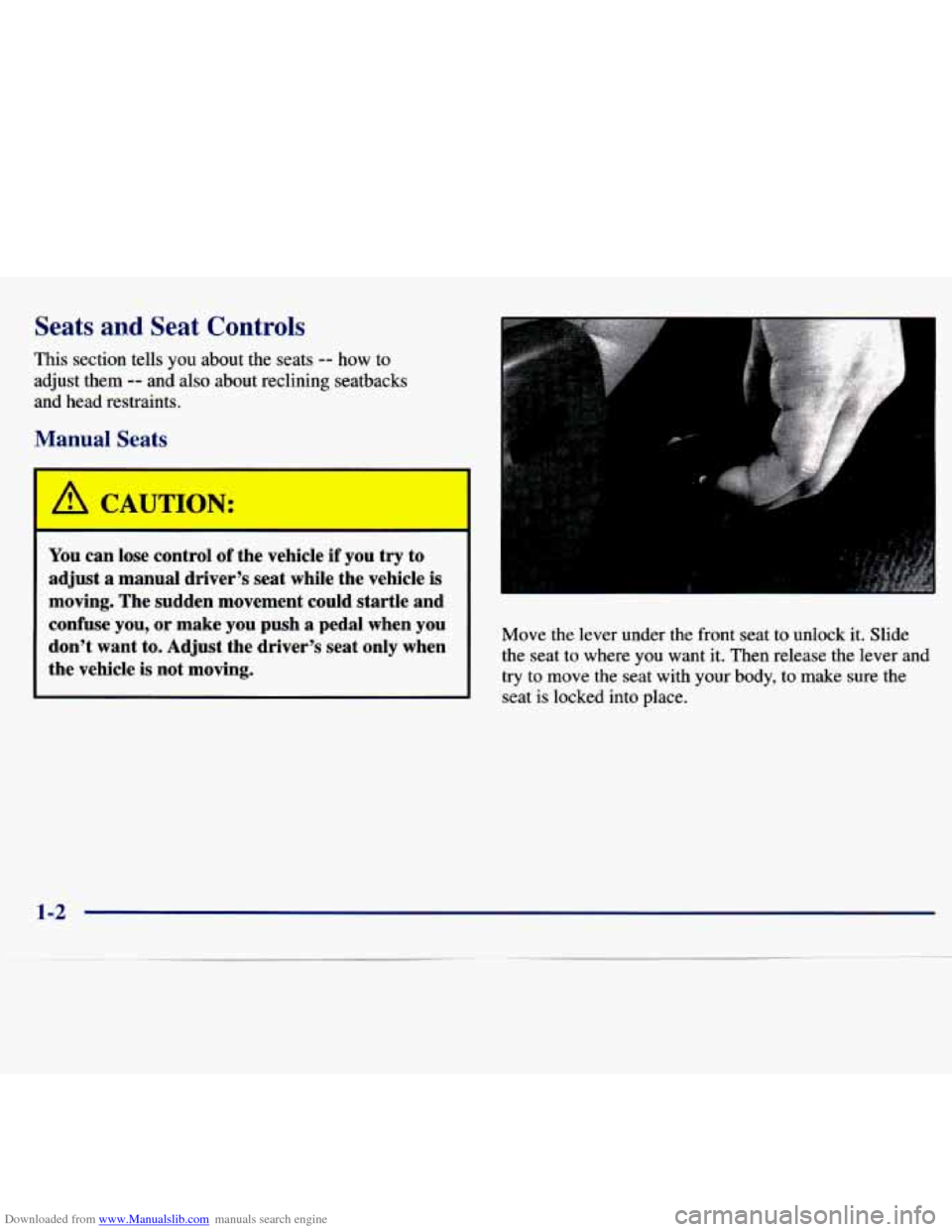
Downloaded from www.Manualslib.com manuals search engine Seats and Seat Controls
This section tells you about the seats -- how to
adjust
them -- and also about reclining seatbacks
and head restraints.
You can lose control of the vehicle if you try to
adjust a manual driver's seat while the vehicle is
moving. The sudden movement could startle and
confuse you, or make you push
a pedal when you
don't want to. Adjust the driver's seat only when
the vehicle is not moving. Move the lever under the front sear IO unlock it. Slide
the seat to where you want it. Then release the lever and
try to move the seat with your body, to make sure
the
seat is locked into place.
1-2
Page 87 of 354

Downloaded from www.Manualslib.com manuals search engine A warning chime signal will come on if you have left
your turn signal on
for more than 3/4 mile (1 km).
As you signal a turn or a lane change, if the arrows flash
rapidly, a signal bulb may be burned out and other drivers won’t see your turn signal.
If a bulb is burned out, replace it to help avoid an
accident. If the arrows don’t go on at all when you
signal a turn, check for burned-out bulbs and then check
the fuse (see “Fuses and Circuit Breakers” in the Index).
Headlamp High/Low Beam
To change the headlamps
from low beam to high
beam, push forward on the
turn signal/multifunction
lever.
To change the
headlamps from high beam
to low beam, pull the turn
signal lever backward.
When the high beams are
on, a light on the instrument
panel also will be on.
Flash to Pass
This feature lets you use your high-beam headlamps to
signal a driver in front of you that you want to pass.
To use it, pull the turn signal/multifunction lever toward
you until the high-beam headlamps come
on, then
release the lever to
turn them off.
Windshield Wipers
You control the windshield wipers by moving the stalk
with the wiper symbol on it up or down.
2-30
Page 103 of 354

Downloaded from www.Manualslib.com manuals search engine Accessory Power Outlet
The accessory power outlet
is located to the right of the
ashtray. Just lift up the door
to reveal the outlet.
Garment Hook
Pull down on the outer ring
to use the garment hook.
You can
use it to plug in additional electrical
accessories. Be sure to follow the proper installation
instructions that are included with any electrical accessory you install. The accessory power outlet is
protected by a fuse and has
a maximum current level.
2-46
Page 106 of 354
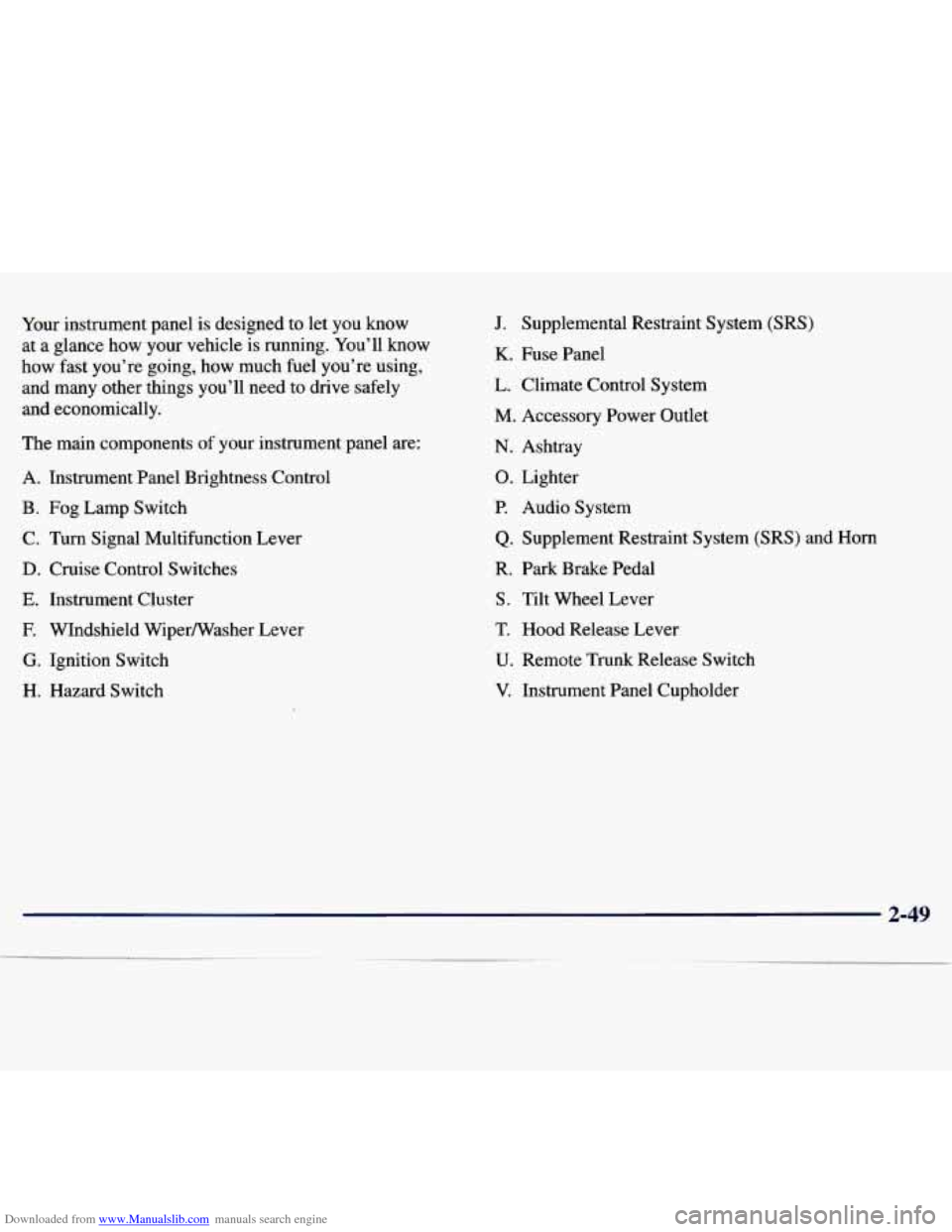
Downloaded from www.Manualslib.com manuals search engine Your instrument panel is designed to let you know
at a glance how your vehicle is running. You’ll know
how fast you’re going, how much fuel you’re using,
and many other things you’ll need to drive safely
and economically.
The main components of your instrument panel are:
A. Instrument Panel Brightness Control
B. Fog Lamp Switch
C. Turn Signal Multifunction Lever
D. Cruise Control Switches
E. Instrument Cluster
E WIndshield Wipermasher Lever
G. Ignition Switch
H. Hazard Switch
J. Supplemental Restraint System (SRS)
K. Fuse Panel
L. Climate Control System
M. Accessory Power Outlet
N. Ashtray
0. Lighter
P. Audio System
Q. Supplement Restraint System (SRS) and Horn
R. Park Brake Pedal
S. Tilt Wheel Lever
T. Hood Release Lever
U. Remote Trunk Release Switch
V. Instrument Panel Cupholder
2-49
Page 117 of 354
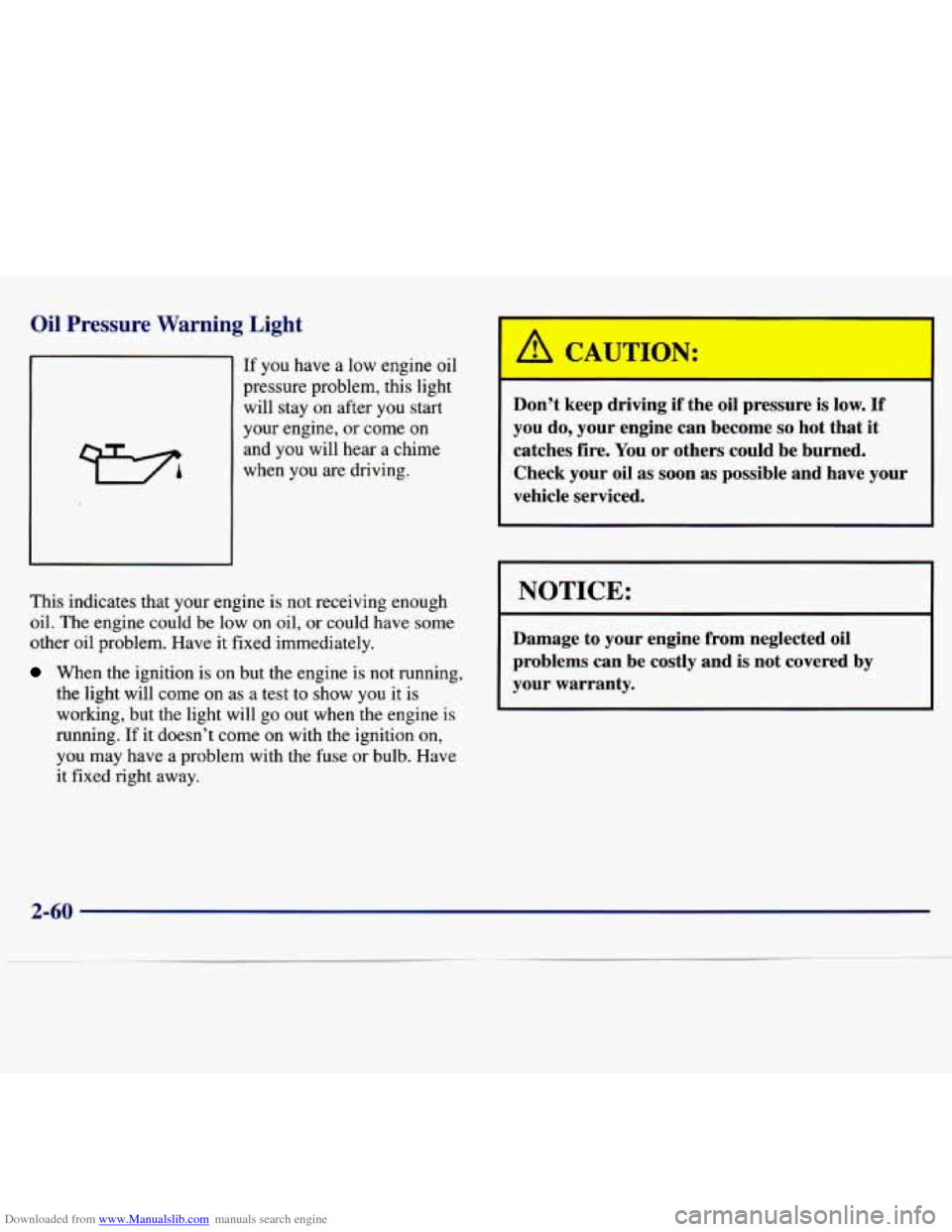
Downloaded from www.Manualslib.com manuals search engine Oil Pressure Warning Light
If you have a low engine oil
pressure problem, this light
will stay
on after you start
your engine, or come on
and you will hear a chime
when you are driving.
This indicates that your engine
is not receiving enough
oil. The engine could be low on
oil, or could have some
other oil problem. Have it fixed immediately.
When the ignition is on but the engine is not running,
the light will come on as
a test to show you it is
working, but the light will go out when the engine is
running.
If it doesn’t come on with the ignition on,
you may have a problem with the fuse or bulb. Have
it fixed
right away.
J:
Don’t keep driving if the oil pressure is low. If
you
do, your engine can become so hot that it
catches fire.
You or others could be burned.
Check your oil as soon as possible and have your
vehicle serviced.
I NOTICE:
Damage to your engine from neglected oil problems can be costly and is not covered by
your warranty.
2-60
Page 176 of 354

Downloaded from www.Manualslib.com manuals search engine To tow your vehicle with all four wheels on the ground,
follow these steps:
t
m
7 ---
1. Position the vehicle to tow and then secure it.
2. Turn the ignition switch to OFF.
3. Set the parking brake.
4. Remove the following fuses from the left side
instrument panel fuse block:
A) Radio, B) Wiper,
H) Powertrain Control Module and K) Body
Function Control Module, Cluster. This will
prevent your battery form draining while towing. See “Instrument Panel Fusle Block-Left” in
Section
6 for location of the fuses.
5. Turn the ignition switch to ACC.
6. Shift your transaxle to NEUTRAL (N).
7. Release the parking brake.
Remember to replace the fuse once you reach your
destination.
To replace the fuse:
1. Set the parking brake.
2. Remove the key from the ignition switch.
3. Replace the fuse.
I NOTICE:
Make sure that the towing speed does not exceed
55 mph (90 kmh), or your vehicle could be
badly damaged.
4-29
Page 222 of 354

Downloaded from www.Manualslib.com manuals search engine 0 Section 6 Service a-- - Aopearance Care
Here you will fiid information about the care of your Chevrolet. This section begins with service and fuel
information, and then it shows how to check important fluid and lubricant levels. There is also technical information
about your vehicle, and
a part devoted to its appearance care.
6-2
6-3 6-5
6-5
6-7
6-
12
6-18
6-18
6-23
6-24
6-28
6-29
6-29
6-35
6-36 Doing
Your Own Service Work
What Kind of Fuel to Use
Using Fuel in Foreign Countries
Where to Put the Fuel and Filling the Tank
Checking Things Under the Hood
Checking Your Engine Oil
Automatic Transaxle Fluid
Engine Coolant
Where to
Fill the Windshield Washer Fluid
Important Brake Information
Information on Your Vehicle's Battery
Tips on Vehicle Storage
Bulb Replacement Procedures
Windshield Wiper Blade Replacement
How and When to Check Tire Inflation 6-39
6-42
6-44
6-47
6-48
6-50
6-5 1
6-52
6-53
6-54 6-55
6-6 1
6-6
1
' 6-62
i 6-62 When
it is
Time to Buy New Tires
Wheel Alignment
Cleaning the Inside of Your Vehicle
Care of the Safety Belts
Cleaning the Outside
of Your Vehicle
How to Clean Aluminum Wheels
Underbody Maintenance
Recommended Appearance Care Materials
Your Vehicle Identification Number (VIN)
The Electrical System
Fuses and Circuit Breakers
Replacement Bulb Types for Your Vehicle
Capacities and Specifications
Air Conditioning Specifications
Normal Replacement
Parts
Page 224 of 354
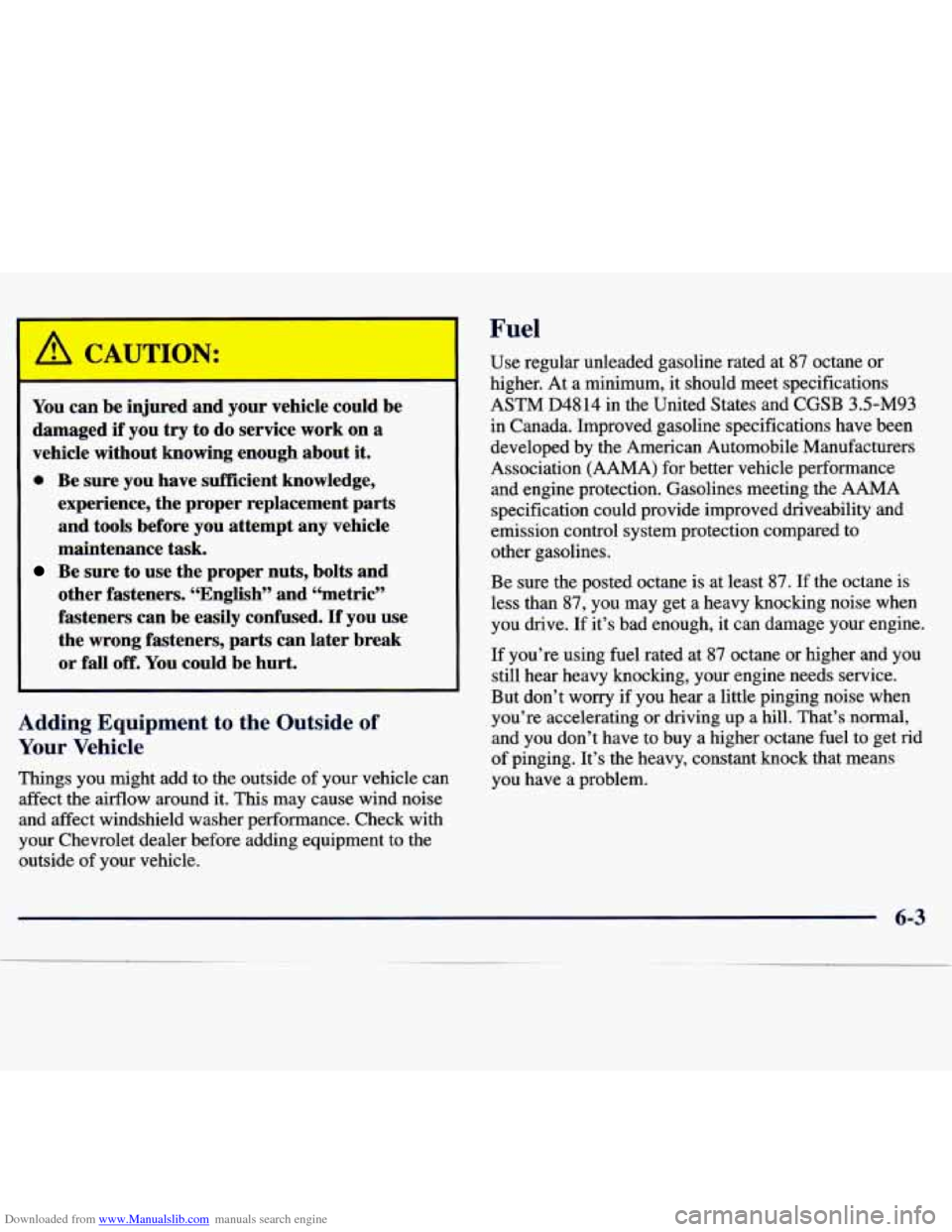
Downloaded from www.Manualslib.com manuals search engine Fuel
/r CAUTION:
You can be injured and your vehicle could be
damaged if you
try to do service work on a
vehicle without knowing enough about it.
0 Be sure you have sufficient knowledge,
experience, the proper replacement parts
and tools before you attempt any vehicle
maintenance task.
Be sure to use the proper nuts, bolts and
other fasteners. “English” and “metric”
fasteners can be easily confused.
If you use
the wrong fasteners, parts can later break
or fall
off. You could be hurt.
Adding Equipment to the Outside of
Your Vehicle
Things you might add to the outside of your vehicle can
affect the airflow around it. This may cause wind noise
and affect windshield washer performance. Check with
your Chevrolet dealer before adding equipment to the
outside of your vehicle. Use regular unleaded gasoline rated
at
87 octane or
higher. At a minimum, it should meet specifications
ASTM D4814 in the United States and CGSB 3.5-M93
in Canada. Improved gasoline specifications have been
developed by the American Automobile Manufacturers
Association (AAMA)
for better vehicle performance
and engine protection. Gasolines meeting the AAMA
specification could provide improved driveability and
emission control system protection compared to
other gasolines.
Be sure the posted octane is at least
87. If the octane is
less than 87, you may get a heavy knocking noise when
you drive. If it’s bad enough, it can damage your engine.
If you’re using fuel rated at 87 octane or higher and you
still hear heavy knocking, your engine needs service.
But don’t worry if you hear a little pinging noise when
you’re accelerating or driving up a
hill. That’s normal,
and you don’t have to buy a higher octane fuel to get rid
of pinging. It’s the heavy, constant knock that means you have a problem.
6-3
Page 275 of 354
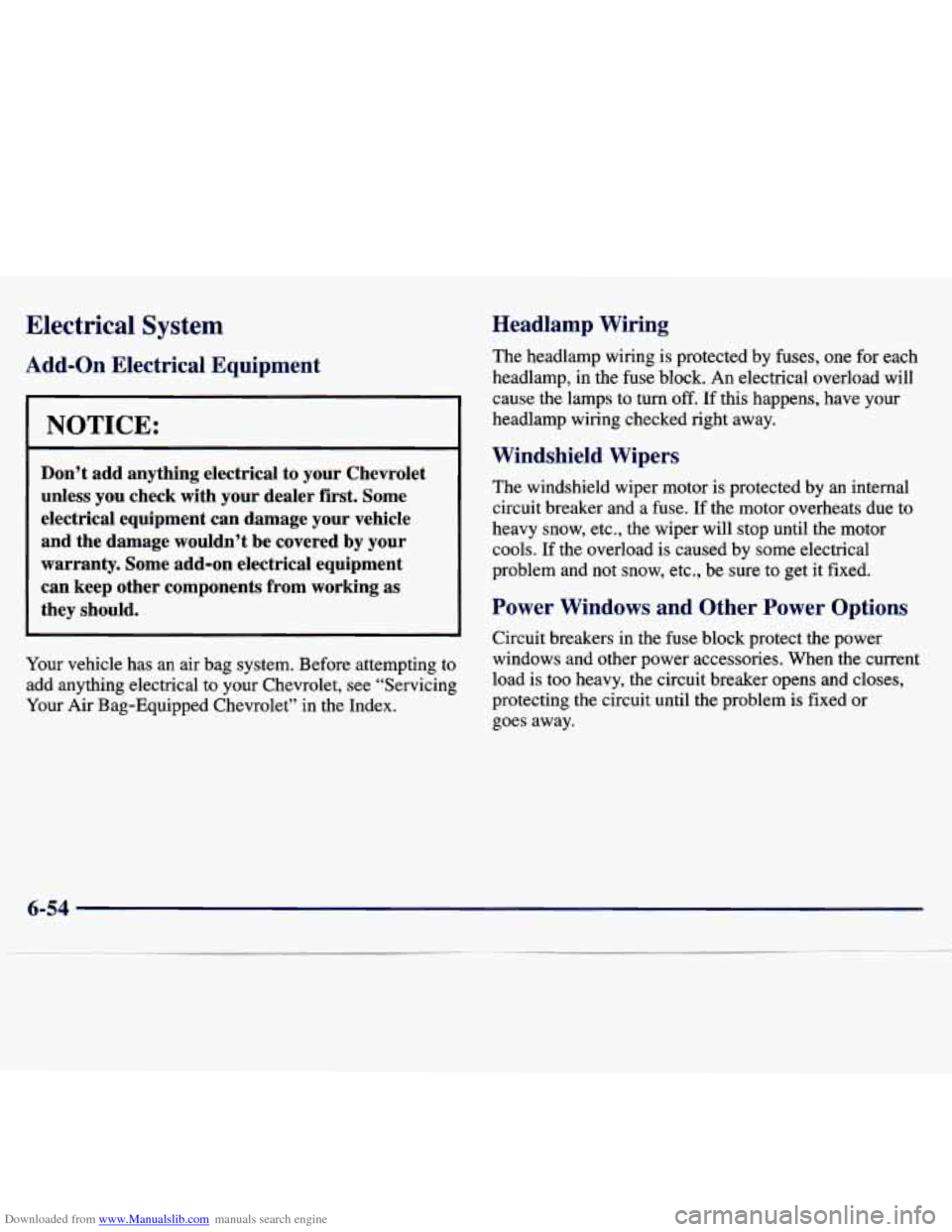
Downloaded from www.Manualslib.com manuals search engine Electrical System Headlamp Wiring
Add-on Electrical Equipment
NOTICE:
Don’t add anything electrical to your Chevrolet
unless you check with your dealer first.
Some
electrical equipment can damage your vehicle
and the damage wouldn’t be covered by your
warranty. Some add-on electrical equipment
can keep other components from working as
they should.
Your vehicle has an air bag system. Before attempting to add anything electrical to your Chevrolet, see “Servicing
Your Air Bag-Equipped Chevrolet” in the Index. The
headlamp wiring is protected by fuses, one for each
headlamp, in the fuse block.
An electrical overload will
cause the lamps to turn
off. If this happens, have your
headlamp wiring checked right away.
dshield Wipers
lne windshield wiper motor is protected by an internal
circuit breaker and a fuse.
If the motor overheats due to
heavy snow, etc., the wiper will stop until the motor
cools. If
the overload is caused by some electrical
problem and not snow, etc., be sure to get it fixed.
Power Windows and Other Power Options
Circuit breakers in the fuse block protect the power
windows and other power accessories. When
the current
load is too heavy, the circuit breaker opens and closes,
protecting the circuit until the problem
is fixed or
goes away.
6-54